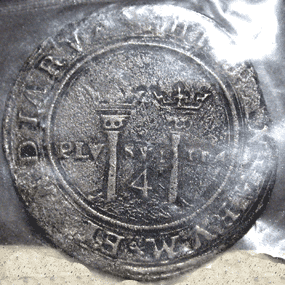
NPS photo Padre Island National Seashore is fortunate to have the National Park Service's largest collection of coins from the Spanish Colonial era. During the time of their use, these coins were called reales (singular: real, pronounced ray-AL in Spanish, plural ray-AL-es). Many of these coins came from the wrecks of three Spanish ships that went aground during a storm in 1554. However, some may have come from other ships that wrecked on the island or may have washed up from shipwrecks elsewhere in the Gulf. There are undoubtedly other sources as well. Some of these pieces are quite rare. A few are displayed here. Please note that these coins have been numbered and enclosed in archival-quality plastic bags. If you would like to ask about a coin, please refer to it by its number, which is usually visible in the photo. Here is a quick tutorial on Spanish reales: Reales from the reigns of two kings can be seen in our collection. The first is from the reign of Ferdinand and Isabella, who commissioned Columbus's initial voyage to the new world. The second is from the reign following that of Ferdinand and Isabella, that of King Carlos and his mother Queen Johanna, who ruled jointly. The reales from these eras are referred to by the names of the reigning monarchs; there are Ferdinand and Isabella reales and Carlos and Johanna reales. Here are the basic design elements common to all Carlos and Johanna coins. Note that exceptions may exist for some of the design elements. The front side has the crowned heraldic shield of Leon and Castile: a shield containing two lions and two castles. To the left of the shield usually is an initial (first name or surname depending upon the period) of the assayer. The assayer was the person in charge of the mint that produced the coins. Sometimes, the assayer's initial can be an indication of when the coin was made, but not always. Usually, to the right of the coin is an abbreviation of the name of the mint that produced the coin. On all our coins will be seen "M", which stood for Mexico City, where the first mint in the new world was established in one of Montezuma's palaces that had been seized by Hernando Cortez. Underneath the shield is a pomegranate. Around the edge of the coin is a variation of (due to space concerns and possibly other reasons) the Latin "CAROLVS ET IOHANA REGES", which means "Carlos and Johanna Rulers". This was continued on the reverse. The reverse side has two columns representing the "Pillars of Hercules", which is an ancient name for the Strait of Gibraltar that lies between Spain and Morocco and is the gateway between the Mediterranean Sea and the Atlantic Ocean. One or more dots or a number denotes the denomination of the coin (one dot is one real, two dots is two reales, etc.). Continuing the royal title from the front and around the edge was some variation of "HISPANIARVM ET INDIARVM", which means "of the Spains and Indies". Thus, the entire title reading from the front stated, "CARLOS AND JOHANNA RULERS OF THE SPAINS AND INDIES." As subsets of the basic design are two series of Carlos and Johanna reales. The first was made between 1539 and 1542 and are called the early series. There are maybe a few hundred of this series in existence today. The National Seashore is fortunate to possess a few of these. The later series was made between 1542 and 1572 after a new set of dies and a slightly altered design for making coins arrived at the Mexico City mint. The three basic differences between the two series are: The late series has waves at the feet of the Pillars of Hercules. The early series had the single world "PLUS" in banner across the Pillars. "PLUS" was an abbreviation of the Latin "PLUS ULTRA", which means "more beyond". This meant that there was more (wealth, land, etc.) beyond the pillars of Hercules. On the late series, "PLUS ULTRA" was written across the pillars, though sometimes it was abbreviated for reasons of space. During the coining of the late series, a few more assayers worked at the Mexico City mint and thus a few new initials appear. Most of our coins are from the late series, but we also have a few of the early series. Remember: the PAIS abbreviation and the four-digit number following are an identification number assigned by the National Park Service. If you have questions about the coin, please refer to it by this number. E-mails will be answered in the order they are received. |
Last updated: October 24, 2022
